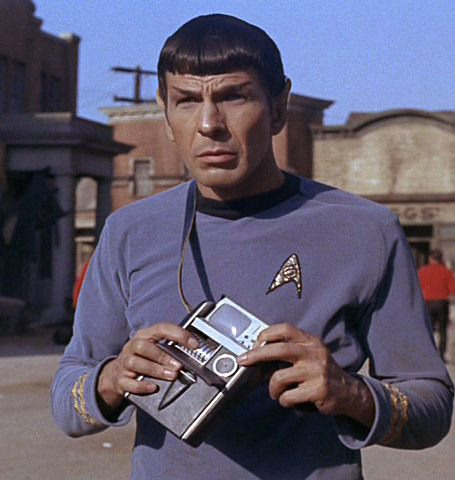

"Fascinating, Jim.... it appears I'll soon have an opportunity to sue for more royalties...."
Posted on 03/18/2006 8:58:01 PM PST by txroadkill
The Star Trek vision of analysing rocks and minerals with the sweep of a handheld device has taken a step towards becoming science rather than science fiction.
"We are developing a tricorder," said Robert Downs, associate professor of geosciences at The University of Arizona in Tucson.
Professor Downs is using a technique called Raman spectroscopy to compile a library of spectral fingerprints for all the Earth's minerals. About 1,500 of the 4,000 known minerals have been catalogued so far.
Although the current Raman spectrometer takes up an area the size of a tabletop, Professor Downs's colleague M. Bonner Denton, a professor of chemistry and geosciences at the University of Arizona, is developing a pocket-sized spectrometer that will be used on the 2009 Mars rover.
A Raman spectrometer fires a laser beam at a sample which excites the mineral's atoms and emits a weak light that has the unique wavelength of the material. "It's like a fingerprint," said Professor Downs.
The technique is named after Sir Chandrasekhara Venkata Raman, who won the Nobel Prize for Physics in 1930 for figuring out the underlying process.
The Raman technique is preferable to other methods of examining minerals as it does not require a piece of the sample to be ground down or polished in a specific way.
One use for a handheld version of the spectrometer would be the identif ication of gemstones.
ping
I want a Ramen spectrometer to find out what Nissin puts in their Cup o' Noodles!


"Fascinating, Jim.... it appears I'll soon have an opportunity to sue for more royalties...."


In related news, William Shatner's 75th birthday is this Wednesday, March 22!
Let's see ...
They have a cell phone that is designed to look like the Star Trek communicator.
We already have had a Commander-in-Chief who slept with every single woman he can.
Now we have a tri-corder on the way.
Now, for the transporter to get some final tweaks .....
And exactly WHEN are we going to mandate mini-skirts for all female crewmembers?

like this???

Space tech ping!
Amazing, isn't it? And Leonard Nimoy's 75th birthday is just 4 days later.
Chandrasekhara Venkata Raman (Tamil: சந்திரசேகர வெங்கடராமன்) (November 7, 1888-November 21, 1970) was an Indian physicist, who was awarded the 1930 Nobel Prize in Physics for his work on the scattering of light and for the discovery of the effect named after him.
Raman was born in Tiruchirapalli, Tamil Nadu. At an early age Raman moved to the city of Visakhapatnam, Andhra Pradesh. He completed his BA and MA in Physics and English from the Presidency College, Madras (now Chennai). He entered Presidency College, Madras, in 1902, and in 1904 passed his B.A. examination, winning the first place and the gold medal in physics; in 1907 he gained his M.A. degree, obtaining the highest distinctions. He joined the Indian Civil Services as an Assistant Accountant General in Calcutta (now Kolkata).
Raman was a professor of Physics at the Calcutta University for the next fifteen years. It was during his stay here that his work on optics was recognized.
Raman won the 1930 Nobel Prize in Physics for his work on the scattering of light and for the discovery of the Raman effect. Raman spectroscopy, based on his effect is also named after him. It was the first time that an Indian scholar who studied wholly in India received the Nobel Prize. An interesting anecdote goes that he booked his tickets to Stockholm several months before the Nobel prizes were announced.
Raman also worked in theory of transverse vibration of strings, his analysis of bowed string on the basis of superposition velocities has an upper-hand in explaining bowed string vibration over Helmholtz.
In 1934, Raman became the director of the newly established Indian Institute of Science in Bangalore, where two years later he continued as a professor of physics. In 1947, he was appointed as the first National Professor by the new government of Independent India. He retired from the Indian Institute in 1948 and a year later he established the Raman Research Institute in Bangalore, serving as its director and remained active there until his death on 1970, in Bangalore, Karnataka, at the age of 82.
He was knighted in 1929 and awarded the Bharat Ratna in 1954.
CV Raman is the uncle of Nobel Prize Physics winner Dr. Subrahmanyan Chandrasekhar.
India celebrates National Science Day on the 28th February of every year. It is on this day that Dr.CV Raman discovered Raman effect in 1928.
When he was offered a toast during the Nobel function: Being a strict teetotaller he responded, "Sir, you have seen the Raman effect on alcohol; please do not try to see the alcohol effect on Raman."

I remember Shatner as a young actor on TV in the early 1960s before Star Trek... Boy, do I feel old!
I do too.
He did at least two Twilight Zone episodes - maybe three.
Yes, but a Star Trek tricorder had three components to it.
As I recall, the three components were BIO, GEO, and MET, which, so far as I know, stood for biology, geology, and meteorology. So I tricorder could scan life forms, rock forms, and presumably predict the weather (although I'm not sure I ever saw it used for that during the show.)
Tricorders have geological, meteorological, and biological functions. That's what the tri- is for. I had one once, labled very accurately to the prop, and I've seen the decal for the prop artwork. Definitely need to add bio and met functions for a real tricorder.
Disclaimer: Opinions posted on Free Republic are those of the individual posters and do not necessarily represent the opinion of Free Republic or its management. All materials posted herein are protected by copyright law and the exemption for fair use of copyrighted works.